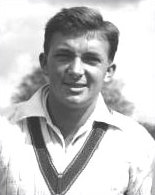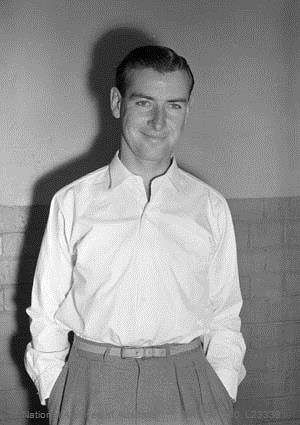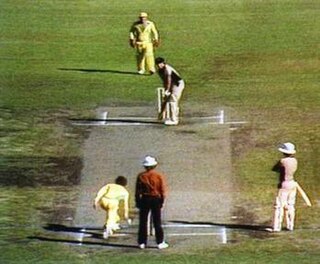Related Research Articles

Richard Benaud was an Australian cricketer who played for New South Wales and Australia. Following his retirement from international cricket in 1964, Benaud became a highly regarded commentator on the game.

Ian Michael Chappell is a former cricketer who played for South Australia and Australia. He captained Australia between 1971 and 1975 before taking a central role in the breakaway World Series Cricket organisation. Born into a cricketing family—his grandfather and brother also captained Australia—Chappell made a hesitant start to international cricket playing as a right-hand middle-order batsman and spin bowler. He found his niche when promoted to bat at number three. Known as "Chappelli", he earned a reputation as one of the greatest captains the game has seen. Chappell's blunt verbal manner led to a series of confrontations with opposition players and cricket administrators; the issue of sledging first arose during his tenure as captain, and he was a driving force behind the professionalisation of Australian cricket in the 1970s.
Gregory Stephen Chappell is a former cricketer who represented Australia at international level in both Tests and One-Day Internationals (ODI). The second of three brothers to play Test cricket, Chappell was the pre-eminent Australian batsman of his time who allied elegant stroke making to fierce concentration. An exceptional all round player who bowled medium pace and, at his retirement, held the world record for the most catches in Test cricket, Chappell's career straddled two eras as the game moved toward a greater level of professionalism after the WSC schism.
Underarm bowling is a style of bowling in cricket. The style is as old as the sport itself. Until the introduction of the roundarm style in the first half of the 19th century, bowling was performed in the same way as in the sport of bowls, with the ball being delivered with the hand below the waist. Bowls may well be an older game than cricket and it is possible that it provided a template for delivering a ball with a degree of accuracy.
Trevor Martin Chappell is a former Australian cricketer, a member of the South Australian Chappell family which excelled at cricket. He played 3 tests and 20 One Day Internationals for Australia. He won the Sheffield Shield with New South Wales twice, and scored a century for Australia against India in the 1983 World Cup. His career was overshadowed, however, by an incident in 1981 in which he bowled an underarm delivery to New Zealand cricketer Brian McKechnie to prevent the batsman from hitting a six.

A delivery or ball in cricket is a single action of bowling a cricket ball toward the batter. Once the ball has been delivered, batters may attempt to score runs, with the bowler and other fielders attempting to stop this by getting the batters out. When the ball becomes dead, the next delivery can begin.
A Tied Test is a Test cricket match in which the side batting second is bowled out in the fourth innings, with scores level. This is a very rare result; only two ties have occurred in the 2,494 Tests played since 1877. The first was in 1960 and the second in 1986. On both occasions, the aggregate scores of both sides (teams) were equal at the conclusion of play and the side batting last had completed its final innings: 10 batsmen had been dismissed or, from the perspective of the side bowling, 10 wickets had been taken. In other words, after four completed innings, with each innings ending either by a declaration or 10 wickets having fallen, the runs for both teams were exactly the same.

Ian Meckiff is a former cricketer who represented Australia in 18 Test matches between 1957 and 1963. A left-arm fast bowler, he is best known for two matters that were unrelated to his skill as a player: he was the batsman run out by Joe Solomon in 1960, causing the first Tied Test in cricket history; and in December 1963, his career was sensationally ended when he was called for throwing in the First Test against South Africa by Australian umpire Col Egar. During the late 1950s and early 1960s, there had been a media frenzy about the perceived prevalence of illegal bowling actions in world cricket. The controversy and speculation that dogged Meckiff in the years preceding his final match caused sections of the cricket community to believe that he had been made a scapegoat by the Australian cricket authorities to prove their intent to stamp out throwing.
Colin John "Col" Egar was an Australian Test cricket umpire.
Bruce Adrian Edgar is a former cricketer who represented New Zealand in both Test and One Day International (ODI) format. A chartered accountant by profession, Edgar played as a left-handed opening batsman and an occasional wicketkeeper during one of New Zealand's most successful eras in international cricket. He gained respect across the cricket world for his courage against the fastest bowlers of his era, his classically straight batting technique, and his outstanding teamwork.

Martin Colin Snedden is a former New Zealand cricketer, who played 25 cricket tests, and 93 One Day Internationals, between 1980 and 1990. He was a member of New Zealand's seam bowling attack, alongside Richard Hadlee and Ewen Chatfield, throughout its golden age in the 1980s.
Geoffrey Merton Griffin was a Test cricketer who toured England with the South African cricket team in 1960, appearing in two Test matches. A right-arm, fast bowler and lower order batsman, his selection for the tour was controversial, because of his suspect bowling action – some of his deliveries were judged to be thrown rather than bowled. The core of his problem was that, due to a childhood accident, he was unable to fully straighten his right arm.
Donald Gordon Weser is a retired Australian Test cricket match umpire, from Western Australia.
Rex Vernon Whitehead was an Australian Test cricket match umpire, from Victoria.

The underarm bowling incident of 1981 is a sporting controversy that took place on 1 February 1981, when Australia played New Zealand in a One Day International cricket match, the third in the best-of-five final of the 1980–81 World Series Cup, at the Melbourne Cricket Ground.
The ComBat was a cricket bat made of aluminium that was the subject of an incident at the WACA cricket ground in Perth in December 1979.

The 1958–59 Ashes series consisted of five cricket Test matches, each scheduled for six days with eight ball overs. It formed part of the MCC tour of Australia in 1958–59, and the matches outside the Tests were played in the name of the Marylebone Cricket Club. The England team led by Peter May was labelled the strongest ever to leave England. It had the formidable bowling attack of Fred Trueman, Frank Tyson, Brian Statham, Peter Loader, Jim Laker and Tony Lock; the all-rounder Trevor Bailey; the outstanding wicket-keeper Godfrey Evans; and the batting of Colin Cowdrey, Tom Graveney, Raman Subba Row and Ted Dexter. They had won the last three Ashes series in 1953, 1954–55 and 1956, but lost the series 4–0 to Australia. It was one of the biggest upsets in Test cricket history and the biggest margin of defeat in an Ashes series since the 5–0 "whitewashing" inflicted by Warwick Armstrong's Australians in 1920–21.

The 1970–71 Ashes series was the 45th edition of the long-standing cricket rivalry between England and Australia. Starting on 27 November 1970, the two sides ended up playing seven Tests; six were originally scheduled, but one extra Test was added to compensate for the abandoned Third Test.
The England team were very unhappy with the umpiring of the 1958–59 Ashes series, in particular the questionable actions of some bowlers in the Australian team. The televising of Test cricket was in its infancy and the notion of Test umpires using slow-motion replays or other modern techniques was considered absurd. Instead the umpires had to make judgements based on what they saw in a split-second, and honest mistakes were accepted as part and parcel of the game. However, touring teams sometimes felt that there was a natural bias towards the home team which led to some acrimony. Keith Miller thought "Mel McInnes, Colin Hoy and Ron Wright were our leading umpires in the 1954-55 M.C.C. tour of Australia, and I have no hesitation in saying that McInnes gave the finest exhibition of umpiring in a Test series that I have experienced". The England team thought well of him too, but in 1958-59 he lost the confidence of the England players and himself, appeared hesitant and gave some surprising decisions. In the Fourth Test he hesitated to give Ken Mackay out even after the batsman walked after snicking a catch off Brian Statham. Later Colin McDonald should have been run out when Fred Trueman flattened the stumps after his runner Jim Burke ran round the back of McInnes. McInnes gave him out, but then changed his mind and gave him not out as he had not seen whether Burke had made the run or not. On his next ball McDonald sportingly pulled his bat out of the way of the stumps to give Trueman "the easiest Test wicket I have ever taken". Trueman was affected again when he batted, given out caught by Wally Grout off Richie Benaud when he had dropped his bat and missed the ball. The England team became dispirited by the umpiring mistakes and, believing the officials to be against them, lost heart. As Fred Trueman wrote
...the Australian umpires demonstrated as much impartiality as a religious zealot. We just couldn't get favourable decisions and they no-balled England bowlers left, right and centre...one of the umpires consistently no-balled me...It was annoying, especially as this umpire seemed to allow Gordon Rorke to bowl with both his feet over the front line!...I suffered, as did others, from appalling umpiring decisions when batting...It was unbelievable."

The 1974–75 Ashes series consisted of six cricket Test matches, each match lasted five days with six hours of play each day and eight ball overs. It formed part of the MCC tour of Australia in 1974–75 and the matches outside the Tests were played in the name of the Marylebone Cricket Club. Ian Chappell's Australians won the series 4–1 and "brutally and unceremoniously wrenched the Ashes" from Mike Denness's England team. It was Australia's first series victory over England for ten years and the experience proved popular as 777,563 spectators came through the gates and paid nearly a million Australian dollars for the privilege. For the first time the first day of the Third Test at Melbourne was held on Boxing Day in an Ashes series, now a cricketing tradition.
References
- ↑ "Peter Cronin". ESPN Cricinfo. Retrieved 16 May 2014.
- ↑ Wisden Cricketers Almanack – 119th edition (1982)
- ↑ Archived at Ghostarchive and the Wayback Machine : W T F Australia??? Why do they cheat at cricket? F*CK! Greg Chappell given not out- GREAT CATCH!. YouTube .
- ↑ Archived at Ghostarchive and the Wayback Machine : W T F Australia??? Why do they cheat at cricket? F*CK! Greg Chappell given not out- GREAT CATCH!. YouTube .
- ↑ The Underarm Ball That Changed Cricket, Abhishek Raghunath, Forbes India, 11 February 2011